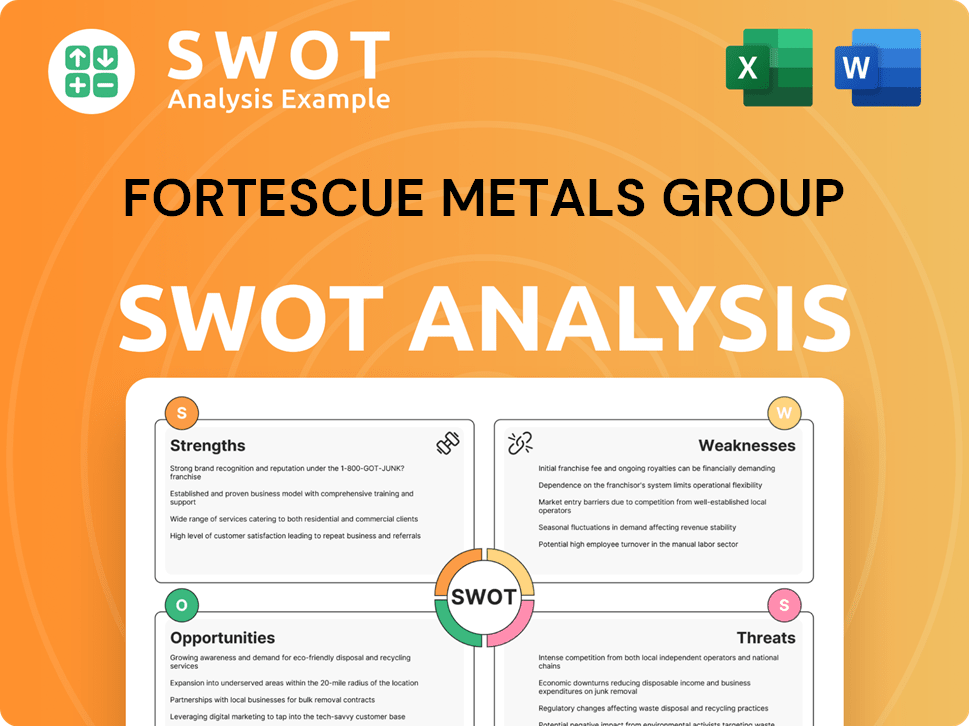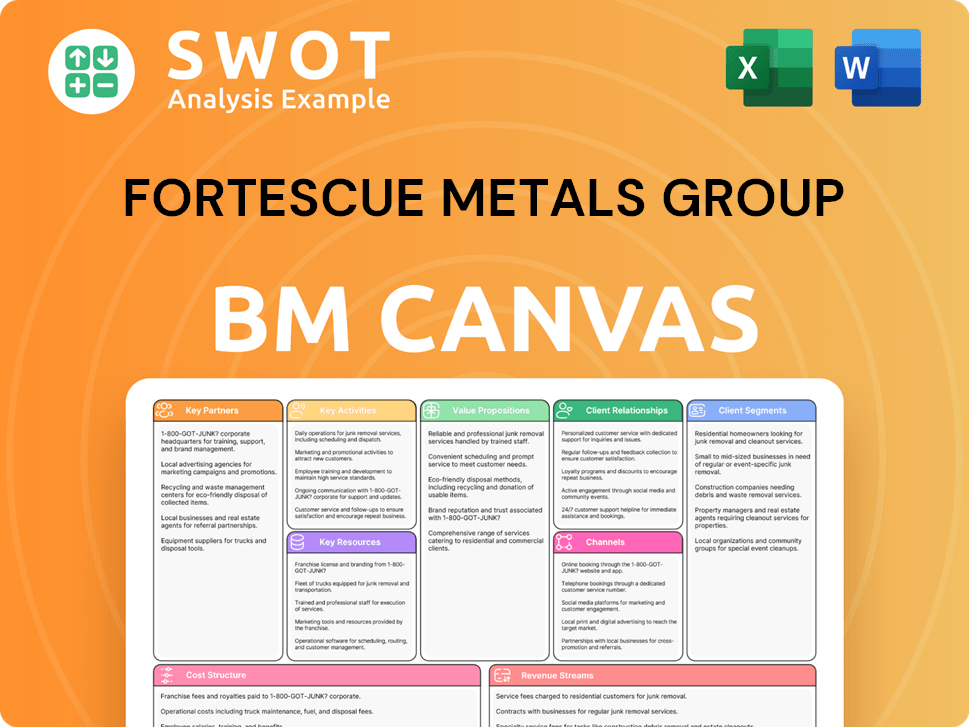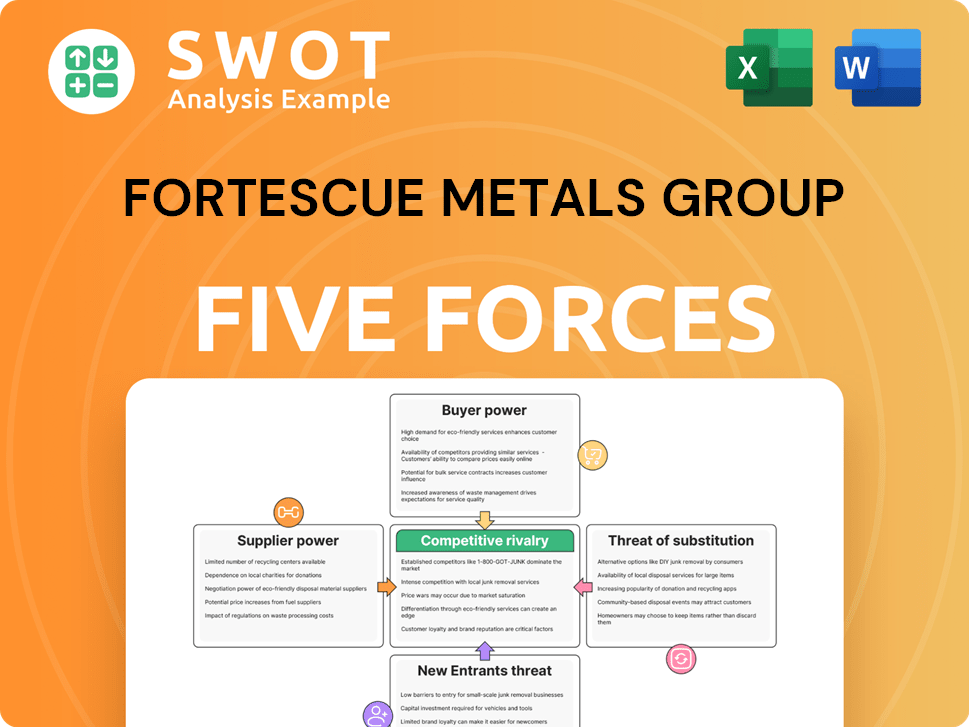Fortescue Metals Group Bundle
Who Really Controls Fortescue Metals Group?
Understanding the ownership structure of Fortescue Metals Group (FMG), a leading Fortescue Metals Group SWOT Analysis can unlock crucial insights. From its inception, the question of who owns the company has shaped its strategic path and market performance. This exploration delves into the evolution of FMG's ownership, examining key figures and institutional holdings that influence its direction.

The story of Fortescue, an Australian iron ore company, begins with Andrew Forrest, who founded it in 2003. Today, as the fourth-largest iron ore producer, understanding the FMG ownership is critical for investors. This analysis will dissect the shareholder structure, revealing the major players and their impact on the mining company's future, including its financial performance and share price.
Who Founded Fortescue Metals Group?
Fortescue Metals Group (FMG), a prominent iron ore company, was established in 2003. The founder, Andrew 'Twiggy' Forrest, played a pivotal role in its inception. His vision was to create a new player in the iron ore market, challenging established competitors.
At its outset, Andrew Forrest held a significant ownership stake in Fortescue. This was crucial for setting the company's initial strategy and securing the necessary funding. While the exact equity distribution at the beginning isn't publicly available, Forrest's personal investment and ability to attract early capital were fundamental to the company's foundation.
Early ownership also involved a network of initial investors and backers who recognized the potential in Forrest's ambitious plans to develop new iron ore mines and related infrastructure in the Pilbara region. These early agreements laid the groundwork for the company's capital structure as it moved towards its IPO. The founding team's vision for rapid growth and challenging established players was directly reflected in the concentration of control initially held by Forrest, enabling swift decision-making and a clear strategic direction in its formative years.
The initial ownership structure of Fortescue Metals Group was heavily influenced by Andrew Forrest's significant stake. This facilitated the company's strategic direction and early funding. Early investors also played a key role in supporting Forrest's vision to develop iron ore mines in the Pilbara region.
- Andrew Forrest: Founder and key initial shareholder.
- Early Investors: Provided capital to support mine development and infrastructure.
- Strategic Direction: Concentrated control allowed for swift decision-making in the early years.
- IPO Preparation: Early agreements shaped the company's capital structure as it moved towards its IPO.
Fortescue Metals Group SWOT Analysis
- Complete SWOT Breakdown
- Fully Customizable
- Editable in Excel & Word
- Professional Formatting
- Investor-Ready Format

How Has Fortescue Metals Group’s Ownership Changed Over Time?
The evolution of Fortescue Metals Group (FMG) ownership began with its initial public offering (IPO) on the Australian Securities Exchange (ASX) in 2004. This event was pivotal, allowing the iron ore company to secure the necessary capital for its large-scale projects. The IPO marked a transition from private to public ownership, introducing a diverse shareholder base and setting the stage for future ownership shifts. Over the years, changes in the shareholder structure have reflected the company's growth and strategic developments.
Since the IPO, the ownership structure of FMG has been influenced by various factors, including market dynamics and strategic decisions. The increasing involvement of institutional investors and the ongoing stake held by the founder, Andrew Forrest, have shaped the company's governance and strategic direction. This has allowed FMG to expand into new energy initiatives while maintaining its core iron ore business. Understanding the ownership dynamics is crucial for investors and stakeholders alike, as it provides insights into the company's strategic priorities and potential future developments. The Marketing Strategy of Fortescue Metals Group also plays a role in how the company communicates its value to shareholders and the broader market.
| Shareholder | Approximate Ownership (as of late 2024/early 2025) | Notes |
|---|---|---|
| Minderoo Group Pty Ltd (Andrew Forrest) | 36% | Largest single shareholder, significant influence over strategic direction. |
| Vanguard Group | Significant | Institutional investor, holding a substantial percentage. |
| BlackRock | Significant | Institutional investor, holding a substantial percentage. |
| State Street Corporation | Significant | Institutional investor, holding a substantial percentage. |
As of late 2024 and early 2025, Andrew Forrest, through his private company Minderoo Group Pty Ltd, remains the primary owner of Fortescue Metals Group, holding approximately 36% of the shares. This significant stake gives him considerable influence over the iron ore company's strategic decisions. Other major shareholders include institutional investors like Vanguard Group, BlackRock, and State Street Corporation, which hold significant but smaller percentages. The presence of these institutional investors reflects a trend towards broader ownership and capital market participation, supporting the company's expansion and strategic initiatives. The shareholder structure continues to evolve, influenced by market conditions and the company's growth trajectory.
Andrew Forrest, through Minderoo Group, is the major shareholder, ensuring significant influence over Fortescue Metals Group.
- Institutional investors like Vanguard, BlackRock, and State Street hold substantial stakes.
- The ownership structure reflects the company's growth and strategic shifts.
- Understanding the shareholder structure is crucial for investors and stakeholders.
- The IPO in 2004 was a key event in the evolution of FMG's ownership.
Fortescue Metals Group PESTLE Analysis
- Covers All 6 PESTLE Categories
- No Research Needed – Save Hours of Work
- Built by Experts, Trusted by Consultants
- Instant Download, Ready to Use
- 100% Editable, Fully Customizable

Who Sits on Fortescue Metals Group’s Board?
The Board of Directors of Fortescue Metals Group significantly influences the company's governance and strategic direction, directly reflecting its ownership structure. As of early 2025, the board includes members who represent the major shareholders, alongside independent directors. Andrew Forrest serves as the Executive Chairman, which highlights his continued influence due to his substantial ownership stake through Minderoo Group. This setup, common in founder-led companies, emphasizes the concentration of power within the organization. Understanding the board's composition is crucial for investors looking at the Target Market of Fortescue Metals Group.
The current board structure ensures that key decisions are made with both founder vision and independent oversight in mind. This balance is crucial for maintaining investor confidence and ensuring the long-term sustainability of the company. The board's role is to oversee the company's strategy, manage risk, and ensure that the interests of all shareholders are considered.
| Director | Position | Details |
|---|---|---|
| Andrew Forrest | Executive Chairman | Founder and major shareholder. |
| Non-Executive Directors | Various | Independent oversight and expertise. |
| Other Directors | Various | Representing diverse backgrounds and skills. |
The voting structure of Fortescue Metals Group follows a one-share-one-vote principle for its ordinary shares listed on the ASX. Andrew Forrest's approximately 36% ownership through Minderoo Group gives him substantial control, influencing board appointments and strategic decisions. There are no publicly disclosed dual-class shares or special voting rights that would grant disproportionate control beyond direct shareholding. This ownership structure is regularly scrutinized by governance experts and investors to ensure a balance between founder vision and independent oversight. The focus remains on ensuring a balance between founder vision and independent oversight. The company's financial performance and shareholder value are closely tied to these governance structures.
Andrew Forrest, through Minderoo Group, holds significant influence as the Executive Chairman and major shareholder.
- The board includes representatives of major shareholders and independent directors.
- The voting structure is based on a one-share-one-vote system.
- Governance experts and investors regularly scrutinize the board composition.
- The company's governance aims to balance founder vision with independent oversight.
Fortescue Metals Group Business Model Canvas
- Complete 9-Block Business Model Canvas
- Effortlessly Communicate Your Business Strategy
- Investor-Ready BMC Format
- 100% Editable and Customizable
- Clear and Structured Layout

What Recent Changes Have Shaped Fortescue Metals Group’s Ownership Landscape?
Over the past few years, the ownership structure of Fortescue Metals Group (FMG) has remained relatively stable. A key aspect of this stability is the continued significant stake held by Andrew Forrest. However, the company's strategic shift towards green energy through Fortescue Energy has begun to attract a more diverse investor base. This pivot is influencing the company's shareholder profile, aligning with broader industry trends focused on environmental, social, and governance (ESG) factors.
The increasing emphasis on ESG considerations among institutional investors is a notable trend. This focus influences investment decisions and portfolio allocations, favoring companies with strong sustainability commitments. Fortescue's investments in green hydrogen and other clean energy projects are likely to attract ESG-focused investors. While founder dilution is common as companies mature, Andrew Forrest's continued significant holding in Fortescue demonstrates a commitment to the company's long-term vision, including its energy transition. There have been no public statements about a change in the primary ownership structure.
| Shareholder | Approximate Ownership (2024) | Notes |
|---|---|---|
| Andrew Forrest | ~36% | Founder and Chairman |
| Institutional Investors | ~45% | Includes various investment funds |
| Retail Investors | ~19% | Individual shareholders |
The focus for Fortescue appears to be on expanding its global reach in both its traditional iron ore business and its burgeoning green energy ventures. For detailed insights into the company's strategic direction, consider exploring the Growth Strategy of Fortescue Metals Group. This will provide a deeper understanding of the company's future plans and how they may impact its ownership dynamics.
Andrew Forrest maintains a significant ownership stake. Fortescue Energy's green energy focus attracts new investors. ESG factors influence institutional investor decisions. The company is expanding globally in iron ore and green energy. No imminent changes in primary ownership structure are expected.
Continued stability in core ownership. Increased interest from ESG-focused investors. Potential for diversification of the investor base over time. Sustained commitment from the founder. Focus on expanding global reach in both iron ore and green energy.
Attracts ESG-focused institutional investors. Influences portfolio allocations towards sustainable companies. Potential for increased stock valuation due to green energy initiatives. Reflects broader industry trends in mining and energy sectors. Supports long-term growth and expansion strategies.
Continued focus on green energy projects and sustainability targets. Potential for further diversification of the investor base. Stable ownership structure with founder's significant stake. Expansion of global operations in both iron ore and green energy. Continued alignment with ESG principles.
Fortescue Metals Group Porter's Five Forces Analysis
- Covers All 5 Competitive Forces in Detail
- Structured for Consultants, Students, and Founders
- 100% Editable in Microsoft Word & Excel
- Instant Digital Download – Use Immediately
- Compatible with Mac & PC – Fully Unlocked

Related Blogs
- What are Mission Vision & Core Values of Fortescue Metals Group Company?
- What is Competitive Landscape of Fortescue Metals Group Company?
- What is Growth Strategy and Future Prospects of Fortescue Metals Group Company?
- How Does Fortescue Metals Group Company Work?
- What is Sales and Marketing Strategy of Fortescue Metals Group Company?
- What is Brief History of Fortescue Metals Group Company?
- What is Customer Demographics and Target Market of Fortescue Metals Group Company?
Disclaimer
All information, articles, and product details provided on this website are for general informational and educational purposes only. We do not claim any ownership over, nor do we intend to infringe upon, any trademarks, copyrights, logos, brand names, or other intellectual property mentioned or depicted on this site. Such intellectual property remains the property of its respective owners, and any references here are made solely for identification or informational purposes, without implying any affiliation, endorsement, or partnership.
We make no representations or warranties, express or implied, regarding the accuracy, completeness, or suitability of any content or products presented. Nothing on this website should be construed as legal, tax, investment, financial, medical, or other professional advice. In addition, no part of this site—including articles or product references—constitutes a solicitation, recommendation, endorsement, advertisement, or offer to buy or sell any securities, franchises, or other financial instruments, particularly in jurisdictions where such activity would be unlawful.
All content is of a general nature and may not address the specific circumstances of any individual or entity. It is not a substitute for professional advice or services. Any actions you take based on the information provided here are strictly at your own risk. You accept full responsibility for any decisions or outcomes arising from your use of this website and agree to release us from any liability in connection with your use of, or reliance upon, the content or products found herein.